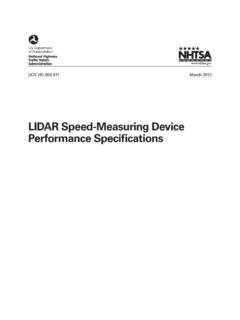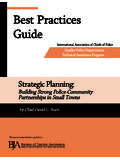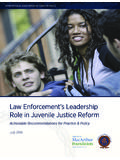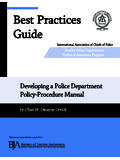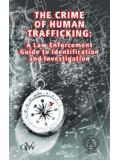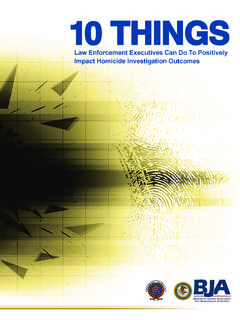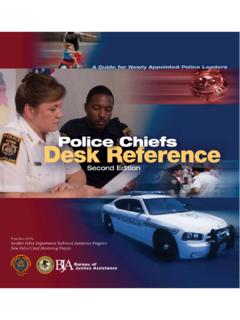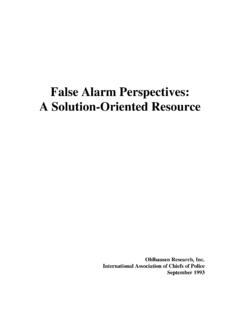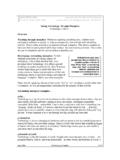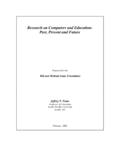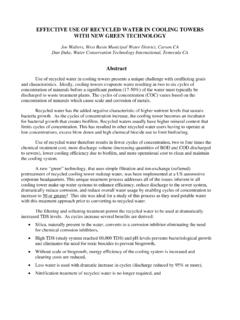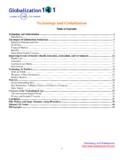Transcription of RESEARCH REPORT 2016 Law Enforcement Use of …
1 JUSTICE POLICY CENTER. RESEA RCH REPO RT. 2016 Law Enforcement Use of social media Survey A Joint Publication by the international association of Chiefs of police and the Urban Institute KiDeuk Kim Ashlin Oglesby-Neal Edward Mohr February 2017. ABOUT THE URBAN INSTITUTE. The nonprofit Urban Institute is dedicated to elevating the debate on social and economic policy. For nearly five decades, Urban scholars have conducted RESEARCH and offered evidence-based solutions that improve lives and strengthen communities across a rapidly urbanizing world. Their objective RESEARCH helps expand opportunities for all, reduce hardship among the most vulnerable, and strengthen the effectiveness of the public sector. ABOUT THE international association O F CHIEFS OF POL ICE. The international association of Chiefs of police (IACP) is a professional association for law Enforcement worldwide.
2 For more than 120 years, the IACP has been launching internationally acclaimed programs, speaking on behalf of law Enforcement , conducting groundbreaking RESEARCH , and providing exemplary programs and services to members across the globe. Today, the IACP continues to be recognized as a leader in these areas. By maximizing the collective efforts of the membership, IACP actively supports law Enforcement through advocacy, outreach, education, and programs. Through ongoing strategic partnerships across the public safety spectrum, the IACP provides members with resources and support in all aspects of law Enforcement policy and operations. These tools help members perform their jobs effectively, efficiently, and safely while also educating the public on the role of law Enforcement to help build sustainable community relations. Copyright February 2017.
3 Urban Institute. Permission is granted for reproduction of this file, with attribution to the Urban Institute. Cover image by Edward Mohr. Contents Acknowledgments iv Survey Highlights v Introduction 1. Background 1. Method 1. Agency Characteristics 2. social media Use 2. social media Management 5. Tone on social media 9. Barriers to the Successful Use of social media by Agencies 11. social media Needs 11. Closing Remarks 13. About the Authors 14. Statement of Independence 15. Acknowledgments This REPORT was the result of work completed by both the Urban Institute and the international association of Chiefs of police (IACP). In particular, we would like to thank Lieutenant Zach Perron of the Palo Alto police Department, Emily Tiry and Sam Bieler from the Urban Institute, and Tracy Phillips and Rebecca Stickley from IACP. The survey also included a number of questions that were previously featured in IACP, LexisNexis, and Socialstrat surveys.
4 For more information about the survey, please e- mail IV ACKNOWLEDGMENTS. Survey Highlights Law Enforcement agencies use social media for a wide variety of purposes. Reportedly, 91 percent use it to notify the public of safety concerns, 89 percent use the technology for community outreach and citizen engagement, 86 percent use it for public relations and reputation management, and 59 percent have contacted a social media company ( , Facebook or Twitter). to obtain information to use as evidence. Agencies have a wide range of experience using social media . Approximately 5 percent of departments have used social media for over a decade, and a similar percentage adopted it only within the last year. Agencies use very different tones on social media . Of those surveyed, 29 percent always or almost always use an informal tone, 45 percent sometimes use an informal tone, and 26 percent almost never or never use an informal tone.
5 Public information officers are the people most often in charge of managing agency social media accounts. This responsibility is also given to a wide range of other people, such as community policing officers or civilian personnel, depending on the department. Of the agencies surveyed, 55 percent have content approved by a central group before being posted online and 44 percent do not. Some of the greatest barriers faced by agencies using social media are adapting to new trends, measuring the impact of their use of the technology, and training personnel to use social media effectively. How long an agency has used social media is not a significant factor in determining how they use the technology. However, agency size is correlated with different outcomes for who is responsible for managing the agency's online presence and the tone used in online posts.
6 SURVEY HIGHLI GHTS V. 2016 social media Survey Background social media use has grown rapidly among police departments, which use the technology to improve community relations, gather intelligence, and shape emerging narratives. In 2015, the President's Task Force on 21st Century Policing recommended that law Enforcement agencies adopt model polices and best practices for technology-based community engagement that increases community trust and access. In response, the Urban Institute (Urban) and the international association of Chiefs of police (IACP) partnered for the seventh annual survey of law Enforcement 's use of social media to understand how police agencies are utilizing the technology. Drawing on IACP's knowledge of the current state of practice as well as RESEARCH by Urban staff, this collaborative survey focused on understanding the various ways agencies use social media , the tone of their online presence, their barriers to success, and their future needs.
7 Method The 2016 social media Survey was designed to build on the findings of previous social media surveys and fill gaps in knowledge on how law Enforcement agencies use the technology. In developing the instrument, authors scanned the literature on police use of social media , met with key stakeholders and practitioners, and reviewed previously completed social media surveys. Researchers reached out to law Enforcement officials who manage agency social media accounts for their input and to find further areas of RESEARCH . The IACP sent the survey to its US membership via e-mail. A total of 539. law Enforcement agencies representing 48 states and the District of Columbia participated in the survey. The 2016 social media Survey builds on current practitioner-oriented knowledge while creating new findings on how law Enforcement agencies use the technology.
8 Agency Characteristics Agencies that responded to the survey represent a diverse sample of departments. Most participating agencies serve small- to medium-sized jurisdictions, have less than 50 full-time officers, and are local police departments. Sheriff's offices, university police agencies, and highway and state patrols are also represented. The responding departments came from all regions of the United States. The tables below show the characteristics of participating agencies. Jurisdiction population Percentage Count Under 2,499 5% 25. 2,500 9,999 25% 133. 10,000 24,999 25% 134. 25,000 99,999 29% 157. 100,000 999,999 14% 78. 1,000,000 or more 2% 12. Agency size by full-time sworn personnel Percentage Count 1 9 9% 51. 10 24 28% 150. 25 49 21% 113. 50 99 17% 94. 100 499 18% 95. 500 or more 7% 36. Agency type Percentage Count Local police 90% 487.
9 Sheriff's office 5% 27. University 3% 16. State 1% 5. a National or foreign 1% 4. Note: Two Canadian agencies responded to the survey. Agency regiona Percentage Count Northeast 22% 117. Midwest 30% 161. South 28% 153. West 19% 103. Notes: The Northeast states were Connecticut, Maine, Massachusetts, New Hampshire, New Jersey, New York, Pennsylvania, Rhode Island, and Vermont. The Midwest states were Illinois, Indiana, Iowa, Kansas, Michigan, Minnesota, Missouri, Nebraska, North Dakota, Ohio, South Dakota, and Wisconsin. The South states were Alabama, Arkansas, Delaware, the District of Columbia, Florida, Georgia, Kentucky, Louisiana, Maryland, Mississippi, North Carolina, Oklahoma, South Carolina, Tennessee, Texas, Virginia, and West Virginia. The West states were Alaska, Arizona, California, Colorado, Hawaii, Idaho, Montana, Nevada, New Mexico, Oregon, Utah, Washington, and Wyoming.
10 2 2016 ANNUAL social media SURVEY. social media Use Respondents were asked questions on how they use social media and their reasons for using the technology. FIGURE 1. Year Agency Started Using social media Number of agencies 90. 80. 72. 62. 52 50. 29. 26. 21 20. 9. 6. Before 2006 2007 2008 2009 2010 2011 2012 2013 2014 2015 2016. 2006. Agencies have a wide range of experience using social media (figure 1). Roughly one in five agencies reportedly started using social media as part of their official operation in 2012. Approximately 5 percent of agencies have used social media for over a decade, and a similar percentage of agencies adopted it only within the last year. FIGURE 2. What Does Your Agency Use social media For? Notifying public of public safety concerns 91%. Community outreach and engagement 89%. Public relations 86%.

